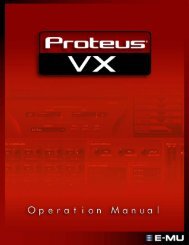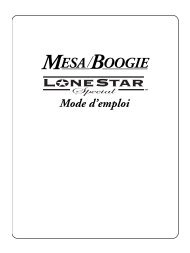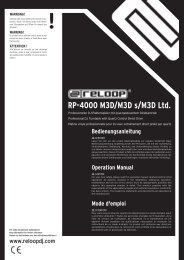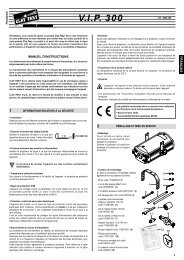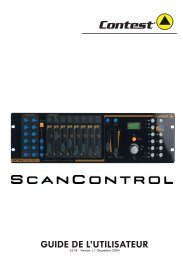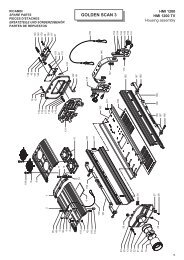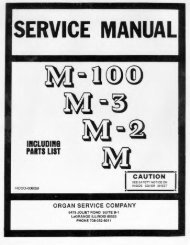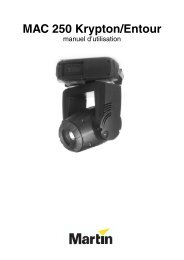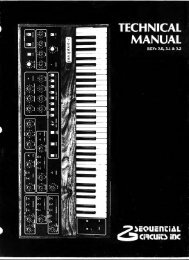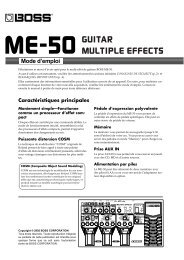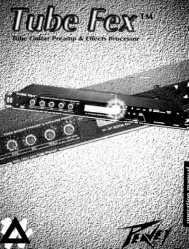Hammond Organ Service Manual - Early Models (A,B ... - Audiofanzine
Hammond Organ Service Manual - Early Models (A,B ... - Audiofanzine
Hammond Organ Service Manual - Early Models (A,B ... - Audiofanzine
You also want an ePaper? Increase the reach of your titles
YUMPU automatically turns print PDFs into web optimized ePapers that Google loves.
PEDAL SOLO UNIT -<br />
U<br />
MODELS RT. RT-2, RT-3. D-IOO<br />
A pedaf solo unit is<br />
incorporated in the concert <strong>Models</strong> to provide a series of bright pedal solo<br />
tones in addition to the usual pedal accompaniment tones available on other models. The pedal<br />
solo tones, generated by a vacuum tube oscillator circuit, are controlled by a volume control knob<br />
and eight tilting stop tablets located at the right end of the Great manual (Fig. 5). One tablet turns<br />
all the pedal solo tones on or off and the others provide various pitch registers and tone colors.<br />
The pedal solo unit is independent of the efectromagnetic tone generator and can be turned off<br />
without affecting the remainder of the organ.<br />
NORMAL ' SOFT VOLUME CONTROL<br />
(<strong>Models</strong> B-2, B-3, C-2. C-3. RT'2. RT-S, A-100, D-100)<br />
This control (Fig. 3} is a tilting tablet which supplements the action of the<br />
expression pedal. In "'soft" position it reduces the volume of the whole<br />
instrument. It is particularly useful when playing in a small room or when<br />
the organist wishes to practice without disturbing others,<br />
CHOR S CQNTROL<br />
(<strong>Models</strong> BC. BCV, D, DV, E)<br />
On these models an extra generator known as a chorus generator will be<br />
foxind. To use the tones generated by this unit at will, one extra black<br />
drawbar has been added which operates a switch located on the generator.<br />
The drawbar labeled "chorus" is located at the right-hand end of the console.<br />
(Fig. 6)<br />
When the organ is played with the chorus drawbar pushed in (the "off'' position)<br />
it operates m exactly the same way as though no chorus were included. Pulling<br />
he drawbar out (to the "on" position) instantaneously adds the ensemble or<br />
-lorus t-ffecl to whatever is being played. Actually it adds a series of slightly<br />
sharp and slightly flat tones to the true tones produced by the main generator.<br />
The resulting electrical wave contams a complex series of undulations which<br />
enhance the pleasing effect of many tone qualities, notably string and full<br />
organ combinations.<br />
The chorus control should not be confusi^d with the "vibrato chorus" effect,<br />
described under "vibrato". The two effects are similar musically, but are<br />
produced by completely different means.<br />
EXPRESSION OR SWELL PEDAL<br />
The swell pedal, located in the customary position, is operated by the right<br />
foot and with it the volume of the organ may be controlled over a wide range.<br />
It operates on the two manuals and pedals equally; that is to say. once the<br />
manuals and pedals are balanced, they retain their relative balance over<br />
the entire swell pedal range.<br />
Two expression pedals are provided for the Model E Console. Both are<br />
equipped with adjustable clamps to regulate the tension and the distance<br />
through which they move. Adjustable pedal indicators, operated by wires<br />
from the rheostat box. are located at the extreme right side of the console<br />
above the Swell manual.<br />
ECHO SWITCH<br />
Located above the starting and running switches<br />
on some consoles is the "echo switch" (Fig. 6).<br />
With this switch it is possible to use two tone cabi<br />
nets and have either cabinet or both speak, depending<br />
on the position of the switch. Generally<br />
one tone cabinet is placed rather distant from<br />
the console and is called the "echo organ". This<br />
feature can be added to a <strong>Hammond</strong> <strong>Organ</strong> by<br />
installation of an "Echo switch kit".<br />
FIGURE 6<br />
1-16



